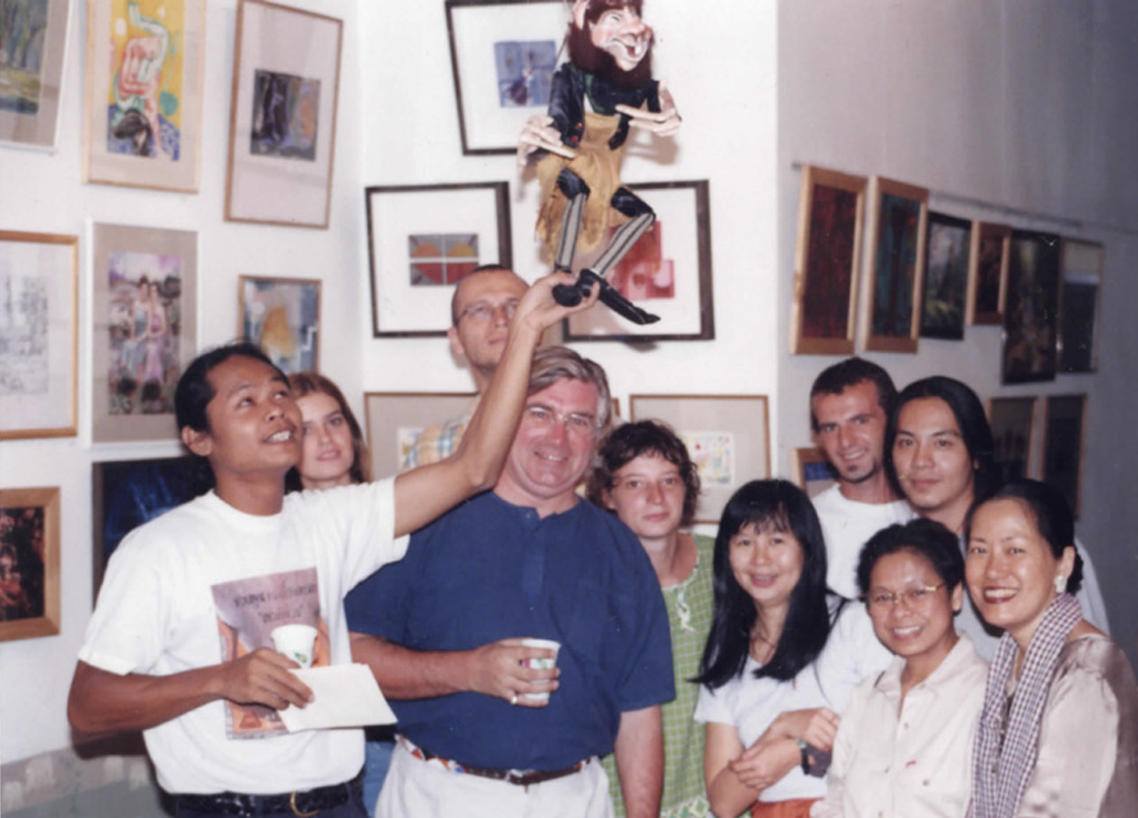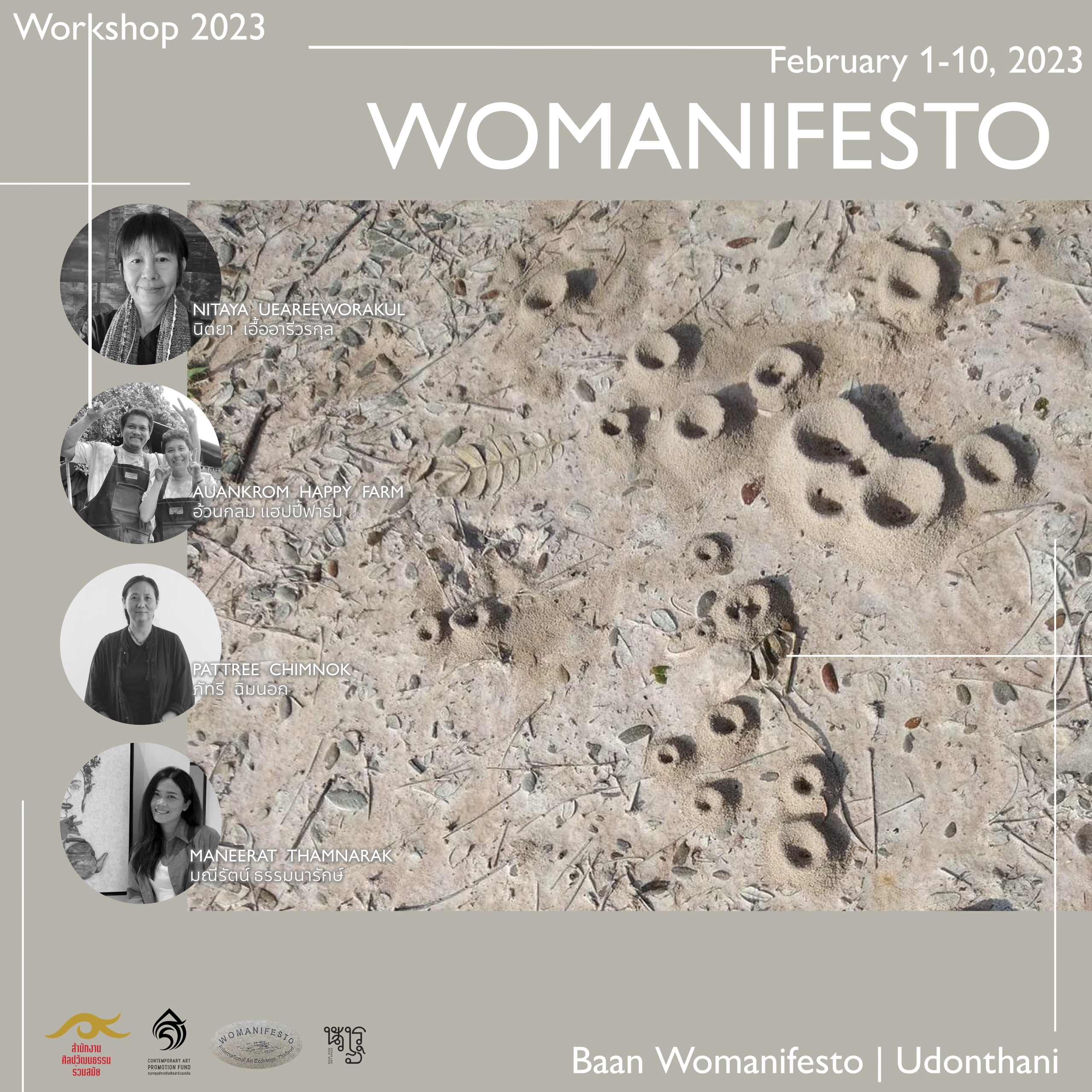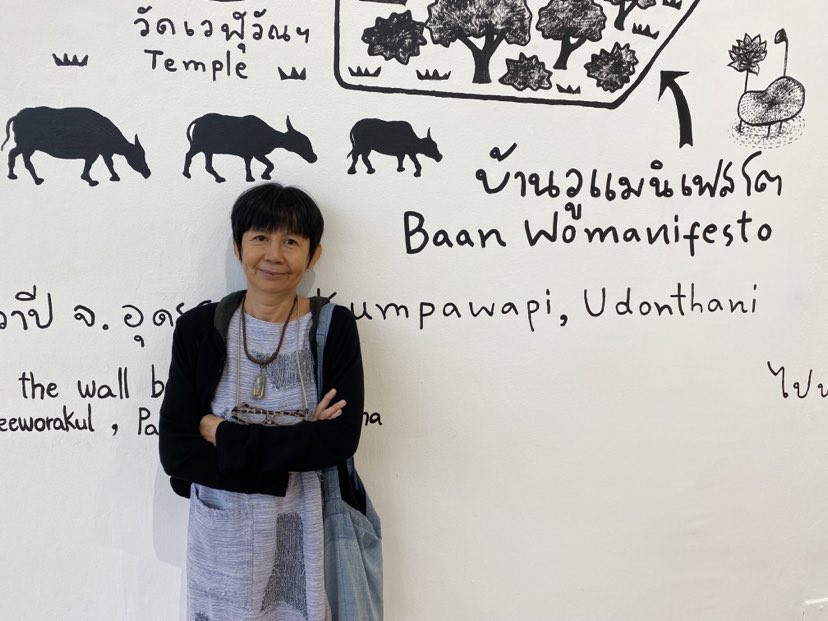By Nitaya Ueareeworakul
Please note that this publication is currently under review and will be subject to changes.
This text was first published in Womanifesto: Flowing Connections, Nitaya Ueareeworakul et al. (eds), exhibition catalogue, Bangkok Art and Culture Centre, Bangkok, 2023, pp. 18–24.
Womanifesto first began to take form as a result of a small gathering of male and female artists at Baan Tuek Art Center in Bangkok, founded by Chumpon Apisuk as a space to present alternative art. It also served as a data centre for EMPOWER Foundation, an independent organisation established to provide educational support and to advocate for laws on female sex workers’ fundamental rights. Baan Tuek Art Center became the centre of gatherings and exchanges between progressive male and female artists, whose artworks aimed at reflecting society, culture, and politics. Together, they also contributed as a driving force in hosting the ‘Tradisexion’ exhibition by female artists in 1995, which was the first exhibition created to raise issues on inequality and to share women’s stories in the form of paintings, texts, poems, installations, and live performances. We faced a barrage of criticism from art and culture journalists and art critics, and some of the criticisms were based on Western interpretations of feminism. However, Mink Noparat, Phaptawan Suwannakudt, and I continued to march on and tried to carry on our ideologies.
The ‘Chiang Mai Social Installation’ event, then, provided us the opportunity to get to know international female artists participating in the event. Therefore, Phaptawan Suwannakudt, Mink Noparat, Rachada Thanaporn, Chumpon and Chantawipa Apisuk, and I began to arrange meetings to discuss and plan an event that would bring together female artists around the world. Mink Noparat came up with the idea to name this project ‘Womanifesto’, with a meaning to assert voices or statements coming from women. We drafted the framework for the project and started to look for funding, which was a crucial step. Finally, we obtained some funding from The Japan Foundation as well as other support from Baan Tuek Art Center and Ark Fongsmut, Director of Baan Chao Phraya. Due to personal reasons in various aspects faced by some committee members, they could not continue organising the project, so only two of us, Phaptawan and I, would take the project forward. Later, with Phaptawan having to move to Australia, we were introduced to Varsha Nair by Rachada Thanaporn who worked at the Art Center of Chulalongkorn University. After having learnt about the project, Varsha became extremely interested and offered a helping hand. Having moved to Australia, Phaptawan stayed in touch through emails, sending her works to be displayed at the exhibitions, and making occasional visits when she travelled back to Thailand.
Fortunately, Varsha Nair moved from England with her husband to Bangkok for a long-term stay and continued the work after Phaptawan relocated. As a result, the two of us became partners who played a major role in organising Womanifesto until we launched the first exchange program in 1997 that included international women artists at two locations simultaneously: Baan Tuek Art Center and Baan Chao Phraya.
After the success of the first project, of course, the challenge of the second one popped up. During that time, I was setting up for the opening of Studio Xang with Pantini Chamnianwai. The studio served as a gallery, a venue for art activities for children, and a space for gatherings of artists with shared ideologies, as well as a destination where the next Womanifesto would take place. We began drafting the framework for ‘Womanifesto II’ , aiming for an open-air exhibition. We gained permission support from Bangkok Metropolitan Administration to use Saranrom Park. We also successfully invited 32 local and international artists. Not only were no invitations rejected, but the word was also spreading much further to the point that the participating artists had to be allocated to various housing facilities, including a guest house, Varsha’s home, and Studio Xang. This achievement was possible due to the support from the Art and Culture Foundation of Bangkok.

The experience gained from being a female artist-organiser of the first and second Womanifesto projects led to the realisation—what lay at the heart of Womanifesto is not the final exhibition of artworks or whether you are an acclaimed artist or not. What is important, however, is the opportunity to learn, meet one another, socialise, tell your own stories, and listen to how everyone is doing within our gathering environments filled with laughter where everyone helps everyone cook and clean up as close family members and friends. This is Womanifesto in our vision: a place of freedom. For this reason, the challenge for us became bigger, and Varsha and I addressed this in our own ways as we moved forward.
Womanifesto Workshop 2001
In 2001, we invited Naomi Urabe to co-curate and Preenun Nana as participant and co-organiser. We also invited Manuporn Luengaram, who joined the initial survey, to visit the farm. It was the first time for us to host the event outside Bangkok and within the community in Isan at Boon Bandarn Farm in Rai Charoen Village, Kantharalak District, Sisaket Province. This is a rural area near the Cambodian border, and the temple of Preah Vihear is also located in the vicinity. The simplicity of the way of life within the Isan community and among traditional folk artisans was the topic we wished to engage with, highlight, and aim to preserve. We were offered support in terms of the farm location by an artist-friend who considered Boon Bandarn Farm a home. Our first journey to the farm was like an exploration into another dimension where the way of life was completely different. This time, the participants in the project consisted of artists, independent curators, and a group of volunteers. We were welcomed by the Parahom family as if we were their own family members. This provided us the opportunity to learn and exchange what we knew about the way of life shared with us by Pan Parahom and Boonchan Parahom, the farm’s owners, as well as their relatives. Their willingness to lend a helping hand resulted in a project filled with wonderful memories to cherish. Our invitation also extended to elderly traditional artisans who still crafted bamboo-woven fishing traps, rice baskets, woven cloth and mats, and carved leather, as well as a group of housewives and Mor Lam Klon singers and musicians. We also paid a visit to a temple for merit making and food offering and attended the Loy Krathong Festival. With funding support from Heinrich Böll Foundation, Thailand, our 10-day stay started with various activities, including educational workshops for schools and the youth, and an open day gathering at the end with works exhibited on site.
Procreation / Postcreation 2003
In 2002, I moved to reside in Kantharalak District, Sisaket Province and gave birth to my first child, a daughter. As a mother, bringing a new life into the world ignited the spark of an idea which led to the ‘Procreation/Postcreation’ publication project organised by Varsha Nair and Preenun Nana, with funding support from The Rockefeller Foundation. This project offered everyone the opportunity to participate by submitting their works in the form of ‘mail art’ via the internet. During the span of one year, the artworks were received, compiled and then published. The publication was launched at Pridi Banomyong Institute, Bangkok, with an exhibition of the artists’ pages, along with videos and live performances.
No Man’s Land 2005/2006
In 2005, as my oldest daughter turned 3, I still lived in Kantharalak District and began offering art classes for children under the name of ‘Baan Sillapa Saengchan’ while also raising my daughter. The circumstances and conditions prevented me from being able to contribute to the project that year. Varsha Nair ran the project by inviting Katherine Olston, an artist based in Chiang Mai, to co-organise, with Keiko Sei as advisor. The online project ‘No Man’s Land’, on the Womanifesto website, aimed to raise issues of borders in the context of the cyberworld, which could be considered a borderless space where we could escape to and reject our state-defined nationalities. Participants around the world engaged in the project through private networks. This was the second Womanifesto project sponsored by the Heinrich Böll Foundation.
Womanifesto Residency Programme 2008
I returned in 2008 to conduct the project once again at Boon Bandan Farm, along with my 6-year-old daughter and 2-year-old son. During that time, there was a political turmoil and conflict in Thailand, and simultaneously Cambodia’s claim to ownership of the Temple of Preah Vihear. Cambodia’s violent clash with Thailand’s army had impacted those villages situated next to the border, and this finally resulted in the closure of the temple’s entrance on Thailand’s side. However, we continued with the residency to place an emphasis on the power of women in the community, in this case led by Pan Parahom. To me, she was a remarkable woman who was not only a mother, a wife, a farmer, but also an accomplished traditional artisan. She wove fabrics from yarn by using barks and other natural materials found on her farm, and she went on to hand sew and embroider clothes. She enjoyed books about Dharma and other topics she found intriguing from time to time. Her inquisitiveness, curiosity, enthusiasm, and willing-ness to learn made me realise that traditional handicraft has contributed and preserved the Isan way of living: a lifestyle that primarily aims to achieve a simple and content way of life. We invited her to participate as an artist with her traditional knowledge and skills in the exchange programme where she worked alongside four local and international contemporary artists for 20 days, hosting us all on her farm. During the time of the residency, we also invited Mor Lam music artists and Isaan Phaya, oral poetry reciters, to join and share their art forms. As before, the artists also set up workshops for schools and the youth to keep up with Womanifesto’s exchange of knowledge. The open-day gathering again invited the community and presented works on-site. The residency was sponsored by the Office of Contemporary Art and Culture, Ministry of Culture.
Womanifesto 2020: Gatherings
After a decade since 2009, when I moved from Sisaket to Ubon Ratchathani, I decided to move back to my hometown in Udonthani where I set up a business called Kokkai Café Art and Craft. This is where Varsha and I planned the ‘Gatherings’ project when the pandemic started with a great impact on everyone, everywhere in the world. We decided to adapt the project to take place locally where artists could gather in the physical space where they lived and meet face to face when possible. Each presented their acitivities to be included on a blog, blog.womanifesto.com, an online platform organised by Lena Eriksson and Varsha Nair. ‘Womanifesto 2020: Gatherings’ was invited for the exhibition ‘Repition as a Gesture towards Deep Listening’, curated by Biljana Ciric for the first Trans-Southeast Asia Triennial research exhibition series, Art Museum of Guangzhou Academy of Fine Arts, China. Later, the online platform, LASUEMO was established by *durbahn, Lena Eriksson, and Varsha Nair to meet on the last Sunday of every month, which continues until today.
Baan Womanifesto Workshop 2023

In 2019, I decided to return and settle down in my hometown in Udonthani Province, Northern Isan region. This new start at 53 years of age took almost three years for me to adjust and settle down in the new environment. In time, just like how Varsha, Phaptawan, and I had been envisioning for a long time, ‘Baan Womanifesto’ was launched to serve as a centre of gatherings and exchanges between artists in the Womanifesto network. In early February 2023, Baan Womanifesto officially opened to offer a combination of a 10-day workshop and residency activities. Invitations were sent to Thai female artists living in different locations, including Chiang Rai, Chumporn, and Udonthani to come share a living space, collabo-rate, exchange knowledge, interact with the community, present an open studio, and most importantly, host workshops for the youth. This was funded by the Office of Contemporary Art and Culture, Ministry of Culture, Thailand. Moving forward, Baan Womanifesto will serve as a place for both short-term and long-term gatherings and activities, where artists can reside and collaborate with one another by engaging with the surrounding community. With a little focus on art education and the fact that no art teachers work in 90 percent of the schools in rural areas, our focus is particularly on educational activities for the school children and local youth. I intend Baan Womanifesto to be an alternative learning platform where knowledge can be widely shared by all.
We are planning to create a community library to store the archive of Womanifesto projects. The library will also serve as a venue for organising homestays for artists. This will be a space where artists, lecturers, and art commentators, part of Womanifesto’s art network who can come together, share their knowledge, and exchange ideas.
Despite having other responsibilities in life and living in different countries, we have managed to keep our bond for 26 years intact. Varsha had been living in Thailand for 24 years before she moved back to India in 2019. Our cultural differences have never been an obstacle for us to work together. We have learnt that inequity exists everywhere in the world and that we need to address it. We have always provided mental support and care for each other. Varsha and Phaptawan have also helped connect Womanifesto to international art networks.
As a woman, I have faced incidents and obstacles in life as an artist, art organiser, daughter, wife, housewife, mother, and eventually, a single mother. I have expressed these realities through my artwork, using bodily shapes, household objects, maternity dresses, family members’ garments, plastic bags, and even leftovers from my children’s exercise books. These objects hold memories and represent a part of my life. I used these objects to take responsibility for the betterment of humanity and the world.
Nitaya Ueareeworakul is a multimedia artist, art curator, and key member instrumental in the establishment of Womanifesto. Born in Udonthani, Thailand, she holds a BFA from the Faculty of Fine and Applied Art at Chulalongkorn University in Bangkok. Her paintings and mixed media installations draw inspiration from personal experiences, with a strong focus on women's emotional issues and social responsibility. Her work aims to raise awareness of various issues impacting women. In addition to her artistic pursuits, Nitaya established and managed Studio Xang, a gallery and children's art workshop space located in Bangkok. Since 1996, Nitaya has been invited to participate in international workshops, artist exchanges, exhibitions, and residency programs. These include Oceasie, an international artist exchange and exhibition held at Temple Du Gout in France (1996); A Step in Africa at the National Museum in Kenya (1999); 2nd Yokohama International Open Air Exhibition From the Asian Forest in Japan (2000); the Khoj—International Artist Workshop in India (2000); and Visual Culture: Tourist Industrial at Forum Stardt Park Graz in Austria (2000).
Related pages
Share a Reflection
log in to share a reflection.
